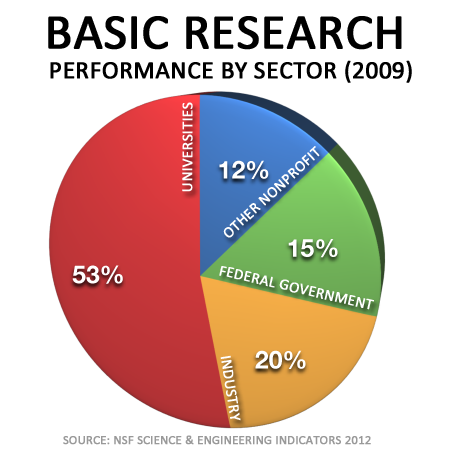Research and the Economy

Science-driven innovation fuels America’s economic growth
 American industry depends on the steady pipeline of knowledge, discovery and innovation that flow from the federally-funded scientific research that is conducted at universities across the nation. The U.S. economy depends on the ability of American industry to use this innovation to create new technologies and new jobs.
American industry depends on the steady pipeline of knowledge, discovery and innovation that flow from the federally-funded scientific research that is conducted at universities across the nation. The U.S. economy depends on the ability of American industry to use this innovation to create new technologies and new jobs.
Since World War II, federally-supported science-driven innovation has fueled as much as half of all economic growth in the United States. It spawned the biotech and semiconductor industries; gave us tools like the laser, GPS and MRI; and through the World Wide Web and the Internet, has entirely changed the way we communicate and conduct commerce.
There are countless measures of the payback on America’s public-private system of research; consider just a few:
- For years, the National Institutes of Health has supported the work of of Duke University and of Stanford University, as they explored G-protein coupled receptor mechanisms. Today of all prescription medications work through these mechanisms and in October 2012, Lefkowitz and Kobilka were awarded the Nobel Prize for Chemistry for their work.
- conducted decades ago is spurring a U.S. energy boom by enabling the extraction of oil and natural gas that was previously thought to be unretrievable. U.S. output of oil and natural gas in 2012 is reaching , providing energy for domestic consumption as well as for sale on the global market.
- Hundreds of companies trace their roots to federally-funded, university-based research, including Google, Genentech, Cisco Systems, SAS and iRobot. A by The Science Coalition identified 100 such companies that collectively employed well over 100,000 people and had annual revenues approaching $100 billion.
- The federally-funded human genome project is credited with creating , generating nearly $1 trillion in economic output, and leading to an ever-growing list of medical treatments, along with potential for expanded agricultural output and other benefits.
- Between 1999 and 2007, contributed $450 billion to the U.S. gross industrial output and created 280,000 new high-tech jobs.
- In 2011, NIH research grants alone supported – directly and indirectly – across the nation.
It simply doesn’t make sense to arbitrarily and drastically cut funding for the fundamental research that fuels American innovation at the very time the United States is trying to spur economic growth and job creation. Deficit reduction requires a more balanced approach.
State Profiles
Learn about research activity in your state

